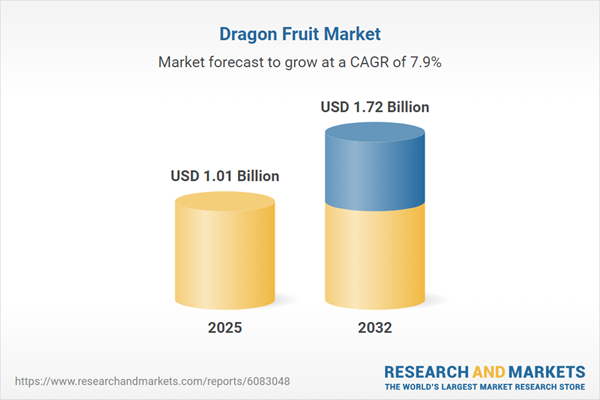Speak directly to the analyst to clarify any post sales queries you may have.
The global dragon fruit market is experiencing dynamic transformation, driven by rising demand for healthy, exotic produce and growing attention to sustainable sourcing. As suppliers and retailers adapt to new market conditions, decision-makers need focused insights to stay ahead in this evolving sector.
Market Snapshot: Dragon Fruit Market Size and Growth
The dragon fruit market grew from USD 943.81 million in 2024 to USD 1.01 billion in 2025. With a projected CAGR of 7.85%, the sector is forecast to reach USD 1.72 billion by 2032.
Scope & Segmentation of the Dragon Fruit Market
This report delivers a detailed breakdown of the dragon fruit market, covering all major product, end-user, and regional segments. A clear understanding of these categories is vital for targeted strategy and operational planning.
- Type: Hylocereus Megalanthus, Hylocereus Polyrhizus, Hylocereus Undatus
- Form: Concentrate (liquid, powder), Dried (powder, slices), Fresh (cut, whole), Frozen (chunks, puree)
- Category: Conventional, Organic
- Packaging: Biodegradable (bags, cartons), Glass (bottled, jars), Plastic (clamshells, trays)
- Application: Animal feed (fodder, treats), Cosmetics (fragrances, haircare, skincare), Food & Beverages (beverages, ice cream, jams, syrups), Nutraceuticals (powders, supplements)
- End User: Businesses (hotels, juice bars, restaurants), Individuals (food & beverage enthusiasts, health conscious), Industries (cosmetic manufacturers, nutraceuticals producers)
- Distribution Channel: Offline (convenience stores, specialty stores, supermarkets & hypermarkets), Online Shopping (dedicated fruit sites, e-commerce platforms)
- Geographical Coverage: Americas (North America, Latin America), Europe, Middle East & Africa (Europe, Middle East, Africa), Asia-Pacific (China, India, Japan, Australia, South Korea, Indonesia, Thailand, Malaysia, Singapore, Taiwan)
- Leading Companies Analyzed: A Natural Farm, Agrideco Vietnam Co., Ltd., EcoFarms USA (The Oppenheimer Group), Frutteto, Hoang Hau Dragon Fruit, Hybrid Herbs, Kumbia Foods, Light Cellar, Madam Sun Sdn.Bhd, Nam Viet Foods & Beverage JSC, Oregon Fruit Company, Peppyflora, PITAYA PLUS, R. Torre & Company, Rawnice AB, ROAR Organic, Sol Organica S.A., Song Nam ITD Co. Ltd., Unicorn Superfoods, Welch Foods Inc., Wilderness Poets LLC
Key Takeaways for Senior Decision-Makers
- Dragon fruit is gaining mainstream recognition as a superfruit, supported by high visibility in premium and specialty retail channels.
- New cultivation methods including greenhouse systems and precision irrigation are facilitating year-round supply and consistent quality.
- Product innovation is accelerating, with extracts and purees increasingly used in beverages, snacks, and nutraceuticals to meet health-conscious demand.
- Traceability and transparency are now top priorities, with blockchain and supply chain certifications strengthening consumer trust and brand credibility.
- Stakeholders are integrating sustainable initiatives, from eco-friendly packaging to energy-efficient processing, aligning with both regulatory trends and customer expectations.
- Strategic partnership models between importers and growers are providing greater risk sharing and operational resilience.
Tariff Impact and Trade Flow Adjustments
New tariffs imposed by the United States in 2025 have disrupted traditional supply chains, prompting importers to seek alternate sourcing routes and investment in operational efficiencies. These changes have heightened the importance of agile procurement models and supply diversification to preserve market position. Efficiency drives, automation, and lean processes are gaining traction as processors adapt to cost pressures and shifting distribution patterns.
Methodology & Data Sources
This report combines in-depth primary interviews across major industry stakeholders with comprehensive secondary research of reputable market reports, regulatory filings, and trade data. Findings have been validated through expert workshops to ensure both industry relevance and analytical rigor.
Why This Report Matters
- Stakeholders gain actionable intelligence to anticipate emerging opportunities in technology adoption, product innovation, and sustainable value chains.
- The report’s clear segmentation enables tailored market entry and expansion strategies for suppliers, processors, and retailers seeking targeted growth.
- Regional analysis uncovers unique trends across Americas, EMEA, and Asia-Pacific, supporting informed investment decisions in key geographic markets.
Conclusion
As the dragon fruit market evolves, leadership will depend on agility, sustainability integration, and strategic collaboration. The right data-driven approach enables business leaders to strengthen competitive positioning and capitalize on new growth opportunities across global markets.
Table of Contents
3. Executive Summary
4. Market Overview
7. Cumulative Impact of Artificial Intelligence 2025
Companies Mentioned
The companies profiled in this Dragon Fruit market report include:- A Natural Farm
- Agrideco Vietnam Co., Ltd.
- EcoFarms USA (The Oppenheimer Group)
- Frutteto
- Hoang Hau Dargon Fruit
- Hybrid Herbs
- Kumbia Foods
- Light Cellar
- Madam Sun Sdn.Bhd
- Nam Viet Foods & Beverage JSC
- Oregon Fruit Company
- Peppyflora
- PITAYA PLUS
- R. Torre & Company
- Rawnice AB
- ROAR Organic
- Sol Organica S.A.
- Song Nam ITD Co. Ltd.
- Unicorn Superfoods
- Welch Foods Inc.
- Wilderness Poets LLC
Table Information
| Report Attribute | Details |
|---|---|
| No. of Pages | 183 |
| Published | November 2025 |
| Forecast Period | 2025 - 2032 |
| Estimated Market Value ( USD | $ 1.01 Billion |
| Forecasted Market Value ( USD | $ 1.72 Billion |
| Compound Annual Growth Rate | 7.8% |
| Regions Covered | Global |
| No. of Companies Mentioned | 22 |









